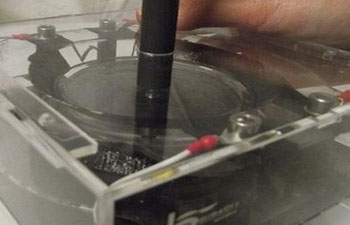New Zealand researches making 'soft' generators
According to the journal Applied Physics Letters, New Zealand scientists are working on making a "soft" mechanical generator, using a variable capacitor to convert energy into electricity.
The research team at the Biological Simulation Laboratory of the Auckland Biological Engineering Research Institute has studied "body-building energy devices," capable of turning the kinetic energy of motion into energy in the battery.

Hand pump soft generator.(Source: Internet).
This generator uses dielectric elastomers, often called "artificial muscles," a flexible material that can generate electricity when deformed.
Dr. Lain Anderson points out that this generator works like a reversible charging pump or a stretchable capacitor. Basically, the material for making "soft" generators needs a non-conductive flexible membrane and a stretchable electrode placed on two surfaces.
Then, the two surfaces of the electrode are coated with an oil carbone, the flexible film is stretched and sprinkled with a little charge. Next, the plastic film is relaxed, the charges are pressed together to push opposite charges apart. Then, the energy is converted into electricity. Flexible membranes have performed the function of a capacitor with diodes, like conventional circuits.
The team also invented the technique of making dielectric elastic switches, which operate on the principle of stretching rubber film to a level where the carbone oil layer no longer conducts electricity. The layer of carbone oil is scanned on one of the surfaces and when the surface is stretched, the oil layer will gradually thin. Small particles containing carbone conductive in this oil layer will move further and further. When the surface is slightly tighter, the resistance will skyrocket. The point of separation between the ability to conduct electricity and cannot conduct electricity is the tension-dependent switch.
The above principle shows that it is feasible to create power generators that can be mounted on the body or carried. In the past, American scientists have developed a generator that uses "artificial muscle" to get energy from the heel rhythm.
However, the team thinks that it is possible that American scientists have attached a type of electronic device to the generator. As for soft generators, the device is a soft material attached to the shoe. So, people who wear shoes still feel very comfortable.
According to Dr. Anderson's team, one step ahead of other research groups in the field of "soft" generators with the removal of electrical components made of hard materials.
However, it takes a long time for this technique to be used in commercial products. Scientists will conduct many other studies to set standards for this type of device, while improving them before putting them into production to create trust for consumers.
- The 'engineer' barefoot built a generator
- Japan studied building generators from water pipes
- A close-up of the 'extremely toxic' fishes off New Zealand
- New equipment: Individual hydroelectric generator
- Emerging icebergs in New Zealand
- If New Zealand is available, where is 'Old Zealand'?
- BAT researches tobacco production more safe
- Successfully manufactured electricity from domestic waste
- The cave is 30 million years old in New Zealand
- Generators operate by virus
- The first fish swimming fast, swimming like fish
- 20 unique 'things' in New Zealand
 Norway built the world's tallest wooden tower
Norway built the world's tallest wooden tower Kremlin
Kremlin Ashurbanipal: The oldest royal library in the world
Ashurbanipal: The oldest royal library in the world Decoding the thousand-year construction of Qin Shihuang shocked the world
Decoding the thousand-year construction of Qin Shihuang shocked the world